Have you ever wondered if your betta fish is truly thriving in its current tank size?
As a dedicated betta fish owner with years of experience, I’ve come to understand that tank size plays a pivotal role in the overall well-being of these captivating aquatic creatures.
There’s a common misconception that bettas can thrive in small bowls or containers, but the truth is quite the opposite.
The debate over the ideal tank size for bettas is often a topic of great interest and concern for many enthusiasts.
So, what exactly is the best tank size for betta fish, and how does it impact their health and happiness?
Mike’s Thoughts

Risks associated with small tanks, such as health and behavioral issues, and highlights key considerations when selecting a tank, like shape and accessories.
I advocate for larger, longer tanks to ensure a healthy environment, reduce maintenance, and accommodate the betta’s swimming needs.
I’ve put a bunch more detail below that expands on the topic, so feel free to read on and leave a comment if you have any questions or reach me on Facebook.
Minimum Tank Size for Betta Fish
When considering the minimum tank size for betta fish, it’s crucial to prioritize the well-being and health of these beautiful creatures.
Betta fish, also known as Siamese Fighting Fish, require adequate space to thrive.
The recommended minimum tank size for bettas is 5 gallons or 19 liters, although beginners are advised to start with at least 8 gallons or 30 liters.
It’s a common misconception to keep bettas in small tanks or bowls, but this can lead to increased stress and illness.
These fish are native to Southeast Asia, where they inhabit densely vegetated shallow waters.
In the wild, bettas claim territories of about 11 gallons on average.
Larger tanks provide a more natural environment, reduce the frequency of water changes, and help maintain better water quality, which is vital for betta health.
Bettas are special fish that breathe from the top of the water. They need to live in a big enough tank so they can grow well, be happy, and live long.
If their home is too small, they might not grow properly, might fight more, and might not live as long.
Hence, it’s imperative to provide a minimum tank size of 5 gallons to ensure the well-being of these captivating fish.
Factors and Tips to Consider Before Buying
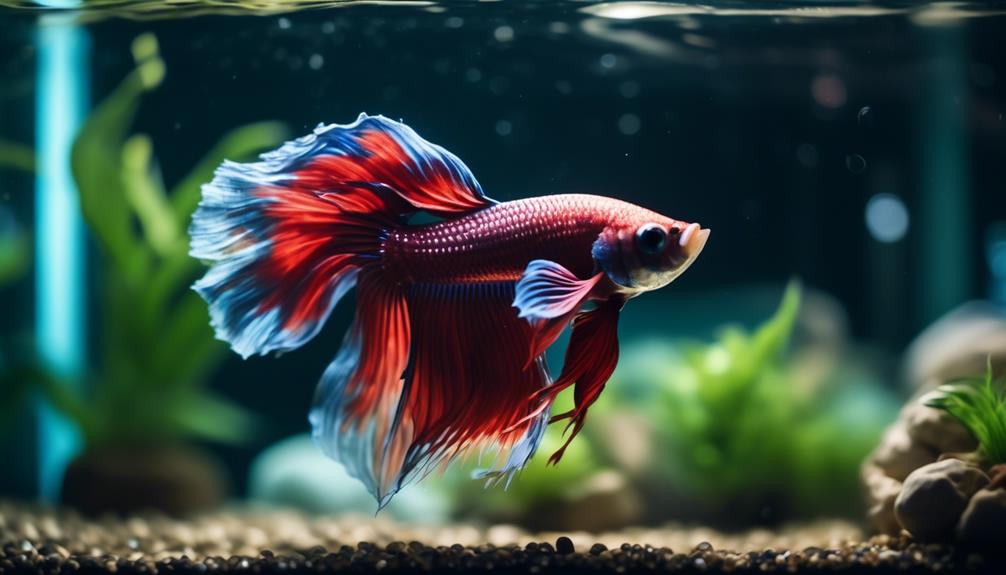
Before purchasing a tank for your betta fish, carefully consider the tank’s shape, accessories, and lid.
The shape and how wide of the tank is crucial as it determines the swimming area for your betta fish.
Tanks with excessive accessories can overcrowd the space, so ensure there’s ample room for your betta to swim freely and also you are able to clean it more efficiently.
A tank lid is essential to prevent bettas from jumping out, ensuring their safety.
In addition to shape and accessories, tank size is also important.
When it comes to tank size, always opt for a larger tank than the minimum requirement to provide ample space for your betta fish. This allows them to swim and explore comfortably.
Maintaining proper water parameters and investing in a good filtration system and a heater is crucial to ensure a healthy environment for your betta fish.
Proper water quality is essential for their well-being and longevity.
If you plan to have other fish in the aquarium, consider the compatibility of potential tank mates.
Not all fish are suitable companions for betta fish, so research their compatibility before introducing them to the same tank.
Bettas Requiring Larger Tank Sizes
Considering the importance of providing a suitable habitat for betta fish, it’s crucial to understand the specific tank sizes required for different betta variations and their individual needs.
While the minimum tank size for bettas is 5 gallons, certain bettas require larger tank sizes.
For instance, Betta splendens may thrive in tanks ranging from ¼ of a gallon to 10 gallons, but a 5+ gallon tank is generally recommended.
Factors such as individual variations, activity levels, and natural habitat should be considered when determining the appropriate tank size.
It’s important to note that bettas, being labyrinth fish, require enough space to access the water’s surface for oxygen.
For betta fish, it’s better to have a long tank than a high one. They like to swim around more, so they need space.
Larger tanks also support better water quality, reducing the frequency of water changes and preventing ammonia buildup.
Therefore, providing a large tank is essential for bettas to thrive, as it not only offers enough space but also contributes to their overall well-being.
Beginner-Friendly Tanks for Betta Fish
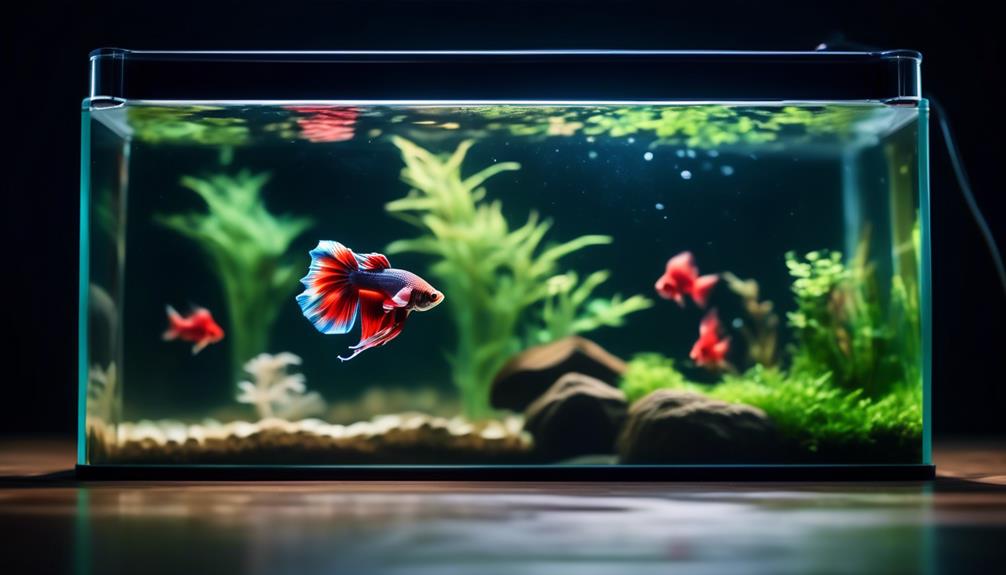
I recommend beginner aquarists to consider a tank size ranging from 5 gallons to 10 gallons for their betta fish, as this will provide ample space for the fish’s well-being.
It’s crucial to avoid small containers or bowls, as these don’t provide a suitable environment for bettas.
Beginner-friendly tanks should prioritize longer tanks over taller ones to accommodate bettas’ swimming habits.
Opting for larger tanks not only reduces the frequency of water changes but also helps in maintaining water quality, reducing the risk of ammonia buildup and promoting a healthier environment for bettas.
When choosing a tank for bettas, factors such as tank shape, accessories, lid, and the need for proper mental stimulation should be considered.
It’s important to note that recommended tank sizes may vary for specific betta types, such as giant bettas, betta sororities, crowntail bettas, and halfmoon bettas.
Ultimately, providing a larger tank for bettas not only ensures their well-being but also enhances the overall experience for aquarists.
Consequences of a Small Tank Size
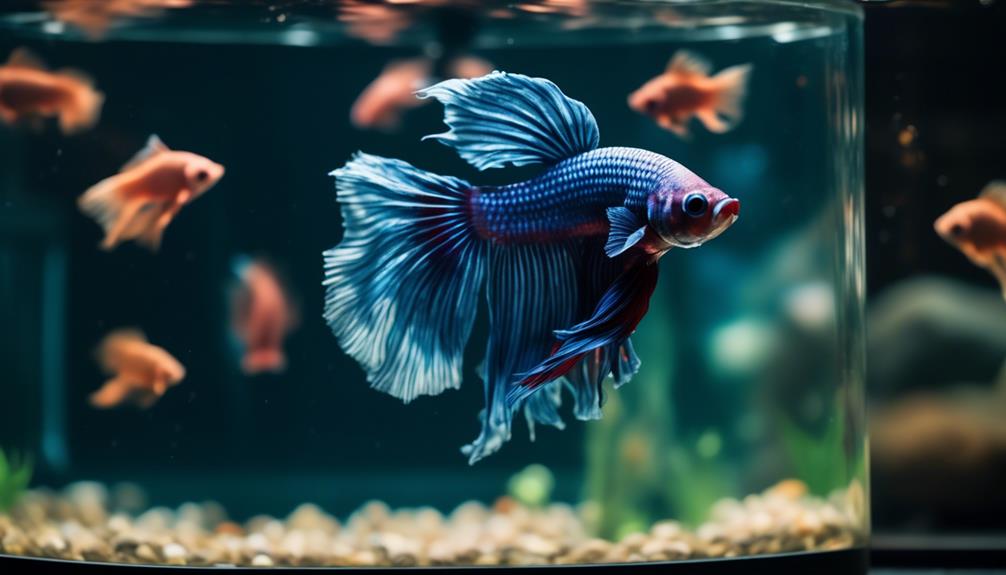
The importance of providing a suitable tank size for betta fish is evident in the consequences of confining them to small tanks.
When bettas are kept in tanks that do not meet the minimum size requirements, several negative effects can impact their overall well-being.
| Consequences of a Small Tank Size |
|---|
| Stunted Growth |
| Poor Water Quality |
| Aggressive Behavior |
| Reduced Lifespan |
| Lack of Mental Stimulation |
Betta fish in small tanks may experience stunted growth due to limited swimming space, which can be detrimental to their health.
Additionally, small tanks are more prone to water quality issues, leading to stress and health problems for bettas.
Limited space can also lead to increased aggressive behavior, resulting in fin nipping and fighting.
Furthermore, bettas kept in small tanks may have a shorter lifespan compared to those in properly sized tanks.
Small tanks offer limited opportunities for bettas to explore and interact with their environment, leading to boredom and stress.
By providing a suitable tank size, betta fish are more likely to thrive, requiring fewer water changes and leading to a healthier, happier betta.
Betta Fish Tank Accessories
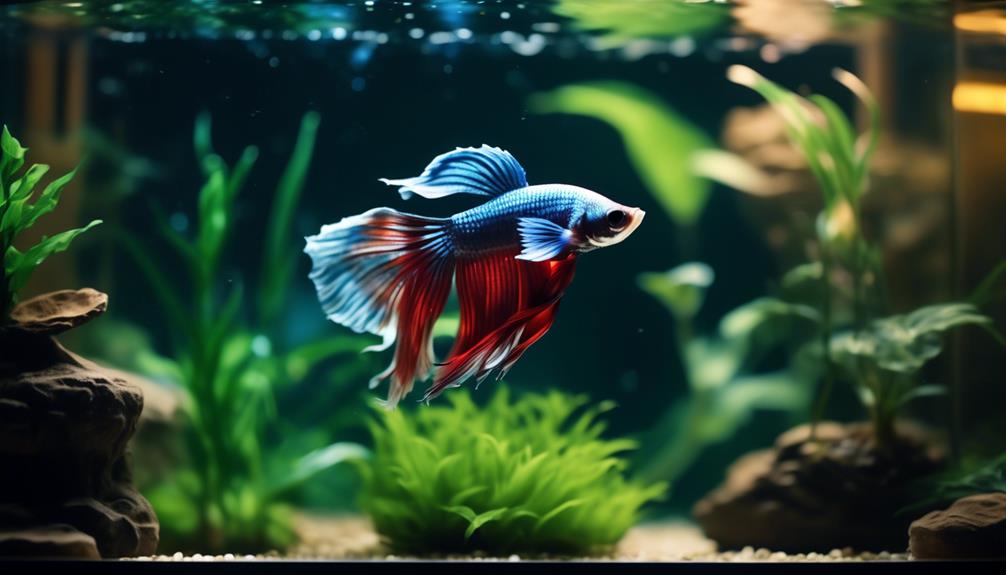
When selecting betta fish tank accessories, it’s important to consider items that provide both functional and aesthetic benefits for the well-being of the fish.
Live plants are excellent accessories for betta fish tanks as they offer hiding spots, help maintain water quality, and mimic the natural habitat of bettas.
Live plants make the fish tank look nice. They help it look pretty for people to see.
It’s crucial to ensure that tank accessories are suitable for the tank size, taking into account the recommended minimum of 5 gallons for betta fish.
Properly sized tanks allow for the inclusion of accessories without overcrowding the space, ensuring the comfort and well-being of the betta fish.
When choosing tank accessories, it’s essential to consider the swimming habits and behaviors of bettas, as well as the need for them to have access to the water surface for oxygen.
Therefore, accessories should be selected to enable easy access to the water’s surface while providing enrichment and stimulation for the fish.
Betta in a Bowl?
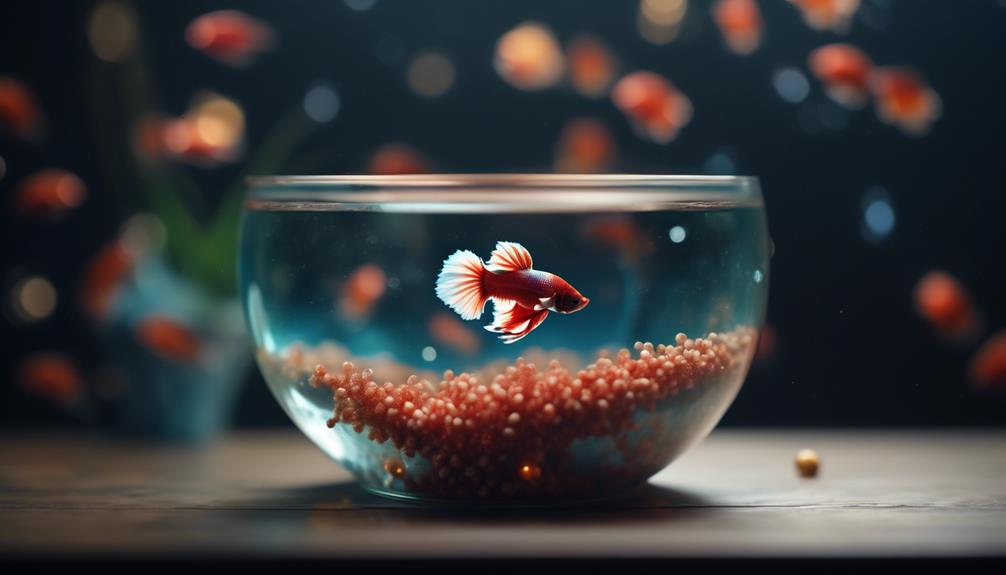
Selecting tank accessories for betta fish, such as live plants, requires consideration of both functional and aesthetic benefits.
When it comes to bettas, the idea of keeping them in a bowl is a common misconception.
While it might seem convenient, the reality is that betta fish need a proper tank environment to thrive.
Bettas require a minimum tank size of 19 liters or 5 US gallons, with a recommended size of at least 30 liters or 8 US gallons for beginners.
Keeping bettas in bowls or small containers can lead to increased stress, illness, and a reduced lifespan.
The small space of a bowl restricts their movement and swimming area, leading to discomfort and unhappiness for the fish.
Bowls are not good for betta fish because they don’t have the right filters or heaters.
This makes the water dirty and too cold, which is bad for the fish’s health.
Inadequate access to proper food and oxygen further adds to the stress on bettas in a bowl.
If you insist to one for your Betta make sure you check how to clean your bowl.
Therefore, it’s crucial to provide betta fish with a suitable tank size and proper fish keeping conditions for their overall well-being.
Why Do Fish Stores Sell Bettas In Small Cups and Vases?
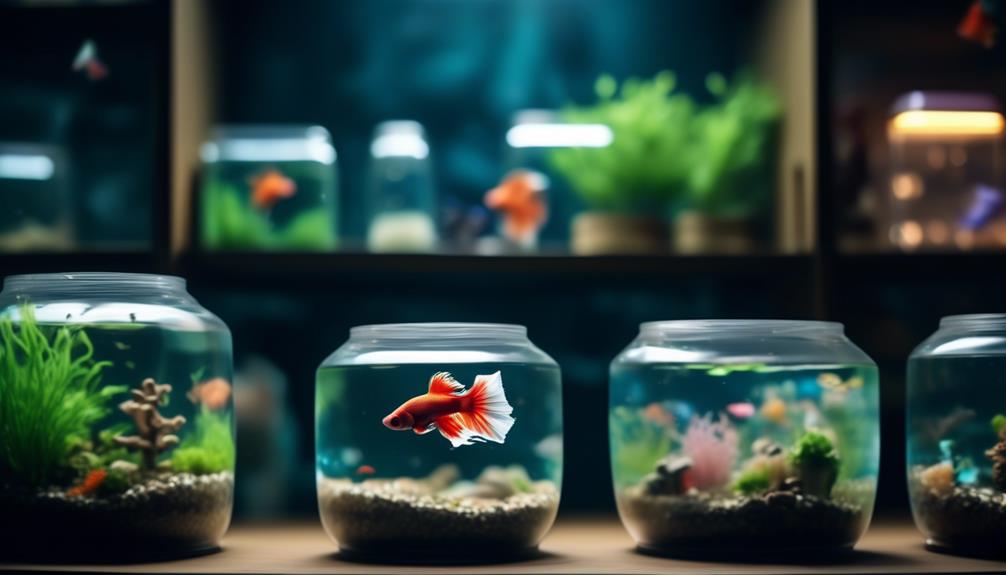
Fish stores sell bettas in small cups and vases due to their convenience for transportation and stacking.
This practice allows for easy transport of multiple bettas, and the compact containers are also simple to stack, optimizing space.
Fish shops save money by using little cups and pots because they take up less room, which makes looking after them cheaper.
Moreover, displaying bettas in small containers can be a marketing strategy to create an illusion of simplicity and low maintenance, which may attract impulse buyers.
It’s important to note that some fish stores may not be aware of the proper tank size requirements for bettas, leading to the sale of inadequate containers.
Unfortunately, there’s also a demand from customers for smaller containers due to space limitations or a lack of awareness about betta care needs.
However, it’s crucial to educate both fish stores and customers about the significance of providing adequate tank sizes for the well-being of bettas.
Frequently Asked Questions
What Is the Best Size Tank for Betta?
I believe the best tank size for betta fish is a minimum of 19 liters or 5 US gallons, but for beginners, it’s better to have at least 30 liters or 8 US gallons. It’s important for the betta’s well-being.
Do Bettas Prefer Tall or Wide Tanks?
I’ve found that bettas prefer longer, more shallow tanks over tall ones. They’re labyrinth fish and need access to the water’s surface for oxygen. Horizontal tanks provide better swimming space for bettas.
Can a Betta Live in a 1-Gallon Tank?
Living in a 1-gallon tank is not ideal for a betta. While they can survive, it’s not the best for their well-being. A larger tank, like 5 gallons, provides a healthier environment, reduces stress, and allows for better care.
Is a 20 Litre Tank Big Enough For a Betta?
A 20-liter tank is suitable for a betta fish.
Is a 10 Litre Tank Big Enough For a Betta?
A 10-liter tank is sufficient for a betta fish, the best size for a betta.
Do Betta Fish Prefer Small or Big Tanks?
I prefer big tanks for betta fish. They thrive in larger spaces due to their natural habitat in Southeast Asia. Big tanks maintain water quality, reduce stress, and support better health for the fish.